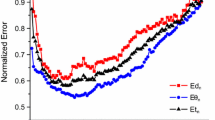Abstract
Cardiac electrical activity was modelled by two realistic generators in a spherical conductor with a centric inhomogeneity. The “Selvester” generator consisted of a 19-dipole array; the “Coriolis” generator was a 76-dipole array. Time varying electric and magnetic potentials at the surface of the sphere were calculated for each array. The inverse cardiac generator was a fixed-location, fixed-orientation, nonnegatively constrained multiple dipole array. Inverse dipole moments were calculated using electric data alone, magnetic data alone, and a combination of electric and magnetic data. The inverse solutions were examined in the presence of additive noise and modelling noise. Modelling noise involved translocating or misorienting the inverse dipoles, or assuming an incorrect conductivity for the inhomogeneity. Results for the Selvester and Coriolis simulations were similar. The mixed data solution using electric and magnetic data gave better results for additive (potential) noise but did not improve the solution in the presence of modelling noise. Septal dipoles showed the greatest errors. In the absence of modelling noise, the mixed data solution for the Coriolis array reproduced the surface magnetic and electric fields very well, but deviated from the ideal solution.
Similar content being viewed by others
References
Barr, R. C. Constrained inverse electrocardiography. Ph.D. Thesis, Duke University, 1968.
Brody, D. A., andHight, J. A. Test of an inverse electrocardiographic solution based on accurately determined model data.IEEE Transactions on Biomedical Engineering (BME) 1972,19, 221–228.
Geselowitz, D. B., andIshiwatari, H. A theoretic study of the effect of the intracavitary blood mass on the dipolarity of an equivalent heart generator. InVectorcardiography Amsterdam: North-Holland, 1965, Pp. 393–402.
Geselowitz, D. B., andMiller, W. T., III. Extracorporeal magnetic fields generated by internal bioelectric sources.IEEE Transactions on Magnetics (MAG) 1973,9, 392–398.
Ideker, R. E., Brody, D. A., Cox, J. W. andKeller, K. W. Examination of a multiple dipole inverse cardiac generator, based on accurately determined model data.Journal of Electrocardiology 1973,6, 197–209.
Grynszpan, F., andGeselowitz, D. B. Model studies of the magnetocardiogram.Biophysical Journal 1973,13, 911–925.
Lynn, M. S., Barnard, A. C. L., Holt, J. H., Jr., andSheffield, L. T. A proposed method for the inverse problem in electrocardiology.Biophysical Journal 1967,7, 925–945.
Miller, W. T., III. The inverse problem of electrocardiography using electric and magnetic data. M.S. Thesis, Pennsylvania State University, March 1974.
Rogers, C. L. Inverse electrocardiography—multistage solutions. Ph.D. Thesis, Duke University, 1967.
Rogers, C. L., andPilkington, T. C. Free-moment current dipole in inverse electrocardiography.IEEE Transactions on Biomedical Engineering (BME) 1968,15, 312–322.
Selvester, R. H., Kalaba, R., Collier, C. R., Bellman, R., andKagiwada, H. A digital computer model of the vectorcardiogram with distance and boundary effects: simulated myocardial infraction.American Heart Journal 1967.74, 792–808.
Wolfe, P. The simplex method for quadratic programming.Econometrica 1959,27, 383–398.
Author information
Authors and Affiliations
Rights and permissions
About this article
Cite this article
Miller, W.T., Geselowitz, D.B. Use of electric and magnetic data to obtain a multiple dipole inverse cardiac generator: A spherical model study. Ann Biomed Eng 2, 343–360 (1974). https://doi.org/10.1007/BF02368094
Received:
Issue Date:
DOI: https://doi.org/10.1007/BF02368094




